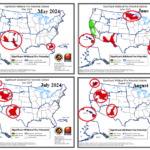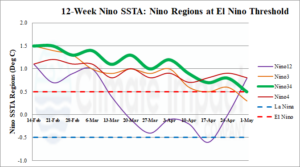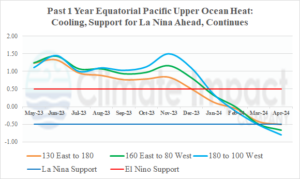
NOAA Fire Risk Outlook May to August 2024: Concern Areas are New Mexico, Great Basin, Washington, and Hawaii
05/05/2024, 12:03 pm EDT
ECMWF “Monthlies” Identify Europe Drought and Hostile North Atlantic TC Season for Summer 2024
05/07/2024, 8:42 am EDT
Fig. 1: Oceanic El Nino is hanging on.
Discussion: The Nino34 SSTA cooled to the El Nino threshold (+0.5C) last week while the entire Nino SSTA region averaged +0.5C, which is slightly warmer than much of April (Fig. 1). Notably, the Nino12 SSTA off the northwest coast of South America warmed dramatically the past 2 weeks. Meanwhile, in the subsurface, the cooling necessary to cause an ENSO phase change from El Nino to La Nina continued. In April, the subsurface equatorial Pacific was cooler and firmly within the La Nina threshold (Fig. 2). The southern oscillation index (SOI) is weakly positive of late after a lengthy period of El Nino-like El Nino negative phase (since February). A sustained period of +SOI and increased trade winds is required to up-well the cool subsurface waters in the equatorial Pacific causing La Nina to emerge.

Fig. 2: Subsurface equatorial Pacific Ocean continues to cool in April.
![Climate-Impact-Company-logo-sm[1]](https://climateimpactcompany.com/wp-content/uploads/2023/08/Climate-Impact-Company-logo-sm1.png)
